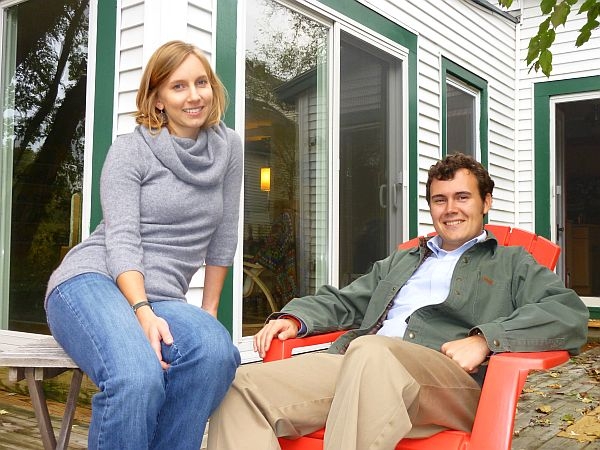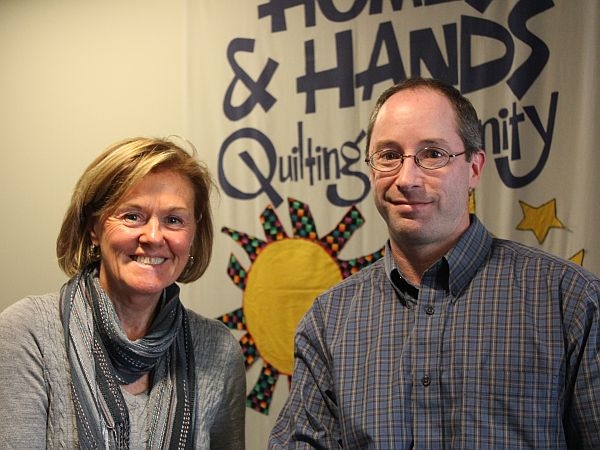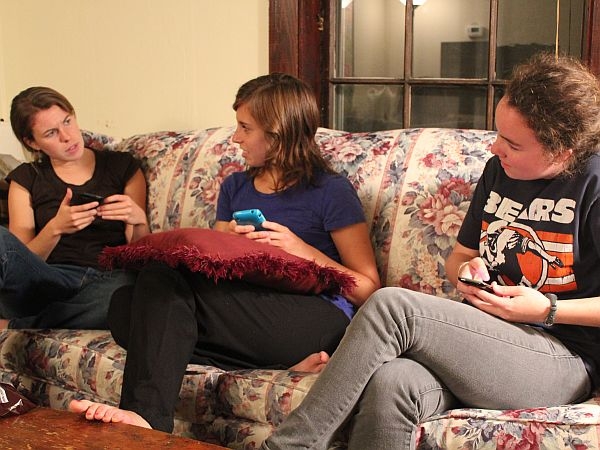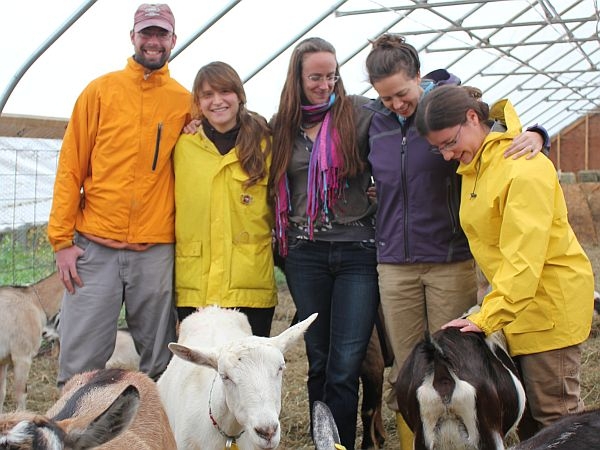
The percentage of young adult Vermonters continues to decline even as the state searches for ways to keep this vital slice of the population here.
The ability to find affordable housing and to manage their debt often influences these young people’s decisions whether to stay, or not to stay, in Vermont.
In the third part of our series on the Generation Gap, VPR’s Fran Stoddard reports.
(Stoddard) Coming of age is an exciting time of independence and discovery, coupled with the challenges of getting a job, living on one’s own, finding a partner, building a nest egg and eventually having a family.
As an expensive and rural state, Vermont holds challenges for these basics of life. Today’s cost of living, particularly housing costs and debt burden, force many in their 20s to compromise or defer their dreams.
While hanging out with her three other 24-year-old roommates, Anna Hill talks about feeling lucky to have found an apartment on the edge of Burlington after graduating from UVM in 2010.
(Hill) "I also know a lot of people our age who I graduated high school or college with who are moving back in with their parents. I’m from Rutland County. People don’t move to Rutland County as much as Chittenden, but I have a lot of high school fiends who stayed in the area. A lot of them haven’t moved out of their parents’ house – or moved out, went to college, lived on campus are and moving back in with their parents because they’re just not making the money they were anticipating they would make. And they have student loans and bills to pay."
(Stoddard) Twenty-six-year-old Mischa Tourin, who has lived on his own in Asia and Washington, D.C., decided to move back to Vermont last year.
(Tourin) "Since I’ve been back I’ve been living with my parents. And I’ve been keeping an eye on what’s out there, as far as rent in Burlington. And it doesn’t seem like there’s very much. I know there’s probably 20-30 people replying to each ad for an apartment in Burlington. So, if it’s affordable, it’s probably pretty well sought after."
(Stoddard) Young Vermonters, struggling to find ways to save, are putting off buying a home and having children. Despite a decent job and lessened expectations, 32-year-old Jonathan Harris is still burdened by student loans and living paycheck to paycheck.
(Harris) "We make ends meet and that’s basically it. Luckily we have a little bit different notion of what is needed, what a more reasonable ‘want’ is than our parents did. I think our expectations are different than the previous generation. We don’t expect to have a 3,500-square-foot house and nor do we really want to. What we would love is to be gaining. We’re put into a position where, because we’re young it’s hard to get credit. It’s hard to get equity, because we can’t get a loan to get a house. We were given debt very freely by the government, but it’s the kind of debt we can’t walk away from. We fulfill our obligations and there’s nothing really left to save at the end of the day."
(Stoddard) Youth have less opportunity and choice today than they did just a decade ago when there were still enough jobs in Vermont that didn’t require a college degree, and housing prices were manageable.
Graduating from Johnson State College in 2008 with a typical $30,000 debt load, Harris is frustrated that despite a two-income household, they can’t manage to save.
(Harris) "I was one of the lucky ones. I make a livable wage, but I have friends who make $10 or $11 an hour that have the same or greater debt burden I do. And I didn’t live at school for three of the four years that I went to school. If I had, I would have more like $50,000 or $60,000 in debt to start with. And the people I know that have that much debt are paying $500 a month and their debt continues to grow. People get stuck as renters for a really long period of time. Why do people put off having kids for a long time? It’s not because we want to party through our 30’s. We want to make the right sort of life for our kids."
(Stoddard) Nationally, the poverty rate and homelessness for young families under 30 is rising considerably faster than any other age group. In Vermont, you hear more stories of kids living in cars in the summer and couch hopping in winter or crashing with friends who have campus housing.
 Brenda Torpy, executive director of the Champlain Housing Trust, and her colleague, Chris Donnelly, know all too well the challenge facing young people today in the housing market.
Brenda Torpy, executive director of the Champlain Housing Trust, and her colleague, Chris Donnelly, know all too well the challenge facing young people today in the housing market.
(Torpy) "Vermont has one of the largest housing-wage gaps in the country consistently, meaning the gap between what housing costs compared to what wages are."
(Donnelly) "Nine out of ten of the most prevalent jobs don’t have wages high enough to pay for a two-bedroom apartment here. We just finished 30 apartments in Essex and as soon as we painted the walls, they were filled. Same thing in Colchester – 42 apartments, as soon as we cut the ribbon they were all filled. There is a two percent vacancy rate in this area."
(Stoddard) Burlington is a desirable spot for young people attracted to the activity and jobs of Vermont’s largest city. But the pressure on the housing market makes it very expensive and out of reach for many.
(Torpy) "There is a shortage of rental housings in this region which has been long standing. And now that home ownership market has slowed down, that’s put more pressure on the apartment market. And rents have actually gone up in this region in this time of downward economy, as far as jobs. We’re already feeling that people aren’t leaving apartments to buy homes, so there’s a great need in rental housing as well. We see that affordable rental housing is so important because it’s very hard for young people to save for a home if they are spending a lot of money on rent. If they’re paying 50-60% of their income on rent, there’s nothing left to save."
(Stoddard) Housemates Kaitlin Francis and Anna Hill, both 24, are aware of the extra financial burden of living in Vermont, but are currently determined to stay.
 (Francis) "You know, the only place to live is Chittenden County, and rents are high and it’s expensive to live here. You have to make some sacrifices sometimes. k I have some friends living in other parts of the country are paying $350 a month for rent. They’re saving money like crazy right now, while the rest of us are living paycheck to paycheck. And I think that’s the huge issue right now — given the job market, is how high rent is."
(Francis) "You know, the only place to live is Chittenden County, and rents are high and it’s expensive to live here. You have to make some sacrifices sometimes. k I have some friends living in other parts of the country are paying $350 a month for rent. They’re saving money like crazy right now, while the rest of us are living paycheck to paycheck. And I think that’s the huge issue right now — given the job market, is how high rent is."
(Hill) "For me, if I had a well-paying job somewhere else, I would still want to come back here. I would take a job that doesn’t pay as much to come back here, rather than not feeling the love someplace else. So I understand, if I wasn’t from Vermont and didn’t have family and friends here, it would be difficult, given the job market and high rent. The cost of living is high."
(Stoddard) To help bridge the divide between rent and home ownership, Champlain Housing Trust developed an internationally recognized program that helps first-time home owners reach their dream. It’s helped couples like Colin and Sara Robinson become homeowners.
(Sara) "Well this, believe it or not, was the first house we looked at and just really fell in love with it."
(Colin) "Do you want us to show you the house?"
(Sara) "The kitchen is my favorite room in the house. It’s cozy and I love being able to make meals for friends here. I just really love the kitchen."
(Stoddard) Colin and Sara Robinson were sweethearts at Brattleboro Union High School. Now married and 27 years old, they chose to settle in Winooski. They are proud to be part of a program that makes their home affordable for generations to come.
(Colin) "It’s called a shared equity program. Our home is in trust to the community. And it’s helping to create – our home whether it is us who live here or families to come, it’s going to be permanently affordable."
(Stoddard) The program provides down payments that are paid back when the house is sold and the trust assures that the house will then be kept in the affordable housing market.
Not all young people gravitate to Burlington or larger urban areas. Many have stayed or settled in rural parts of the state, but it’s not because it’s less expensive to live there. A group of 20-somethings who work at Fat Toad Farm in Brookfield are overwhelmed by the cost of rentals and farmland in Vermont. A chat around the kitchen table with five young farm and food enthusiasts revealed frustrations. Hannah Reid works part-time at her parents’ farm and also for the state.
 (Reid) "We are sitting in the house where I grew up and in the neighborhood where I grew up. My greatest fear is not finding a place I can afford. Ideally I’d like to live within 10 minutes, 15 minutes driving distance max of all my family and everything that’s happening here at the farm. My greatest concern is not being able to find land that’s affordable for me. And so there is this feeling like, I’m from here, these are my roots, this is my place! How can it be that there is nothing I can get squeak into it? I don’t want to say I’m displaced, that’s too extreme. But it’s this feeling of like, Why can’t I come back here more easily?"
(Reid) "We are sitting in the house where I grew up and in the neighborhood where I grew up. My greatest fear is not finding a place I can afford. Ideally I’d like to live within 10 minutes, 15 minutes driving distance max of all my family and everything that’s happening here at the farm. My greatest concern is not being able to find land that’s affordable for me. And so there is this feeling like, I’m from here, these are my roots, this is my place! How can it be that there is nothing I can get squeak into it? I don’t want to say I’m displaced, that’s too extreme. But it’s this feeling of like, Why can’t I come back here more easily?"
(Stoddard) Katie Brodeen, originally from New Hampshire, works at Fat Toad now, but would like to raise a family and run a farm of her own in Vermont.
(Brodeen) "My enthusiasm is somewhat tempered by the fact that I feel somewhat priced out of Vermont land and farming opportunities. This is my actually second attempt at getting launched in farming. But what I’m realizing is that it’s going to be a really big challenge to make enough money farming to afford a farm. With the way that good land is priced and the way that so much good land is going into development, especially in Chittenden County. All of that beautiful farmland is now developments. It’s hard and I’m afraid it may become harder for us to earn enough to actually pay a mortgage. That kind of calls into question the sustainability of farming and whether farming is an option for us. We have to look at, if we rent a house and rent some land, will we earn enough from the land to cover the rent of the land and rent of the house. Will we be able to save enough on top that to be able to ever own a house? That’s a big question for us. It makes it hard to invest in an endeavor and put any infrastructure anywhere if you’re renting."
(Stoddard) Her co-worker Christine Porcaro, chimes in:
(Porcaro) "The capital that you have to put into a farm to get it started, the amount of people you need, even thinking about making money is like, oh my god. As much as I enjoy this, I think there’s another avenue I would want to go initially. Because, along with education I have a lot of student loans, which become very daunting."
(Stoddard) It doesn’t mean they’re giving up or don’t have ideas. Here’s Katie Brodeen’s dream:
(Brodeen) "If older generations want to support people our age in building our dreams, whether it’s farming or not – there’s so much beautiful land in Vermont, and a lot of it actually is being used for agriculture and then some of it actually just big lawns. And when I see a big lawn, I think there could be sheep on that lawn, there could be my sheep on that lawn, there could be vegetables on that lawn. They really want it to stay their lawn. And they can’t kind of think about what their lawn would mean to someone like me who can’t afford land, who can’t afford a house. I want to stay here and build a life here. And everybody could win, and everybody could really like it. I wish there was a mode to make that possible."
(Stoddard) Young people need the same things they have always needed: encouragement, a good job and often a little help.
These days learning how to navigate finances and gain access to credit is more important than ever. Some institutions are helping young people learn more about credit, find affordable housing, or gain access to farm land.
This generation seems particularly aligned with Vermont values. They want to live where land, community and family are more important than profit, but many are finding that Vermont dream out of reach.
Support for The Generation Gap series is provided by VPR’s Journalism Fund.